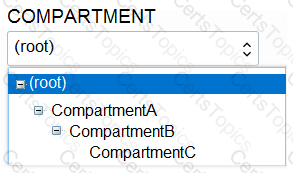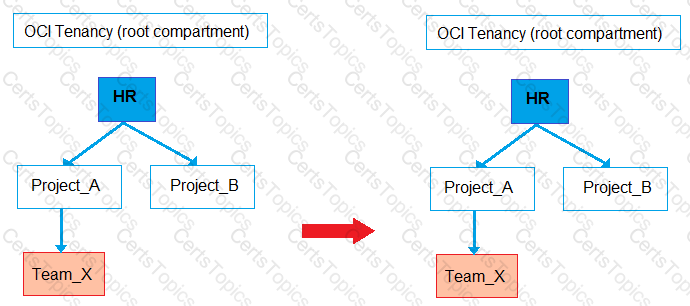You have the following compartment structure within your company Oracle Cloud Infrastructure (OCI) tenancy:

You want to create a policy in the root compartment to allow SystemAdmins to manage VCNs only in CompartmentC. Which policy is correct? (Choose the best answer.)
You have been asked to update the lifecycle policy for object storage using the Oracle Cloud Infrastructure (OCI) Command Line Interface (CLI). Which command can successful-ly update the policy? (Choose the best answer.)
You have been brought In to help secure an existing application that leverages Object Storage buckets to distribute content. The data is currently being shared from public buckets and the security team Is not satisfied with this approach. They have stated that all data must be stored In storage buckets. Your application should be able to provide secure access to the data. The URL that is provided for access to the data must be rotated every 30 days. Which design option will meet these requirements?
One of your development teams has asked for your help to standardize the creation of several compute instances that must be provisioned each day of the week. You initially write several Command Line Interface (CLI) commands with all appropriate configuration parameters to achieve this task later determining this method lacks flexibility. Which command generates a JSON-based template that Oracle Cloud Infrastructure (OCI) CLI can use to provision these instances on a regular basis? (Choose the best answer.)
Which statement about the Oracle Cloud Infrastructure (OCI) instance console connection is TRUE?
You run a large global application with 90% of your customers based in the US and Canada. You want to test a new feature and allow a small percentage of users to access the new version of your application. Which Oracle Cloud Infrastructure (OCI) Traffic Management steering policy should you utilize?
The general syntax for an IAM policy is: Allow
You are an admin of an OCI tenancy. To save cost, you want to restrict the amount of OCPUs that can be provisioned in each compartment. Which will allow this?
Which technique does NOT help you get the optimal performance out of the Oracle Cloud Infrastructure (OCI) File Storage service? (Choose the best answer.)
Multiple teams are sharing a tenancy in Oracle Cloud Infrastructure (OCI). You are asked to figure out an appropriate method to manage OCI costs. Which is NOT a valid technique to accurately attribute costs to resources used by each team? (Choose the best answer.)
Your company has restructured its HR department. As part of this change, you also need to re-organize the compartments within Oracle Cloud Infrastructure (OCI) to align them with the company's new organizational structure. The following change is required:

Compartment Team_x needs to be moved under a new parent compartment, Project_B
The tenancy has the following policies defined for compartments Project_A and Project_B:
Policy1: Allow group G1 to manage instance-family in compartment HR:Project_A
Policy2: Allow group G2 to manage instance-family in compartment HR:Project_B
Which two statements describe the impacts after the compartment Team_x is moved? (Choose two.)
Your company hosts an application on many compute instances in the same subnet in OCI. You have an Ansible playbook to ensure that all instances have the latest versions of dependencies installed.
Which three are required to run the playbook in OCI Cloud Shell?
As a cloud operations engineer responsible for a Rails application on multiple compute instances in an OCI subnet your database team recently provided you with a new config/database. yml file to direct Rails to use a new database back end. You need to update this file on each compute instance and restart Rails in a rolling fashion.
Which tool is best suited for this task?
As a solutions architect of the Oracle Cloud Infrastructure (OCI) tenancy, you have been asked to provide members of the CloudOps group the ability to view and retrieve monitoring metrics, but only for all monitoring-enabled compute instances. Which policy statement would you define to grant this access?
Scenario: 4 (Write Identity and Access Management Policies to Secure a Tenancy)
Scenario Description: (Hands-On Performance Exam Certification)
Your company has signed up for an OCI tenancy to migrate an e-commerce application, a supply chain management (SCM) system, and a customer relationship management (CRM) system. You have been tasked with setting up the requisite identity and access management (IAM) policies for your team to begin developing on OCI.
You start by setting up the following compartment hierarchy:
Tenancy (root)
Common-Infra
Network
Security
Applications
E-Comm
SCM
CRM
You create the following groups:
Network-Admins
Security-Admins
E-Comm-Admins
SCM-Admins
CRM-Admins
Write the IAM policies for the following use cases:
Assumptions:
Assume that all policies will be attached to the root compartment.
Write one policy per given text box.
Keep policies as simple as possible by using verbs instead of permissions (for example, “inspect orm-stacks” instead of “ORM_STACK_INSPECT”) and aggregate resource types instead of individual ones (for example, “file-family” instead of “file-systems” and “mount-targets”)
Task 1
Write a policy statement to enable Network-Admins to create and destroy network-related resources, such as VCNs, subnets, gateways, and so on in the Network compartment.
Task 2
Write policy statements to enable E-Comm-Admins to provision and destroy compute instances in the E-Comm compartment by using networking resources in the Network compartment.[Write one policy per given text box]
Task 3
Write a policy statement to enable SCM-Admins to provision, destroy, and back up block volumes in the SCM compartment—but only in Phoenix and London.
Scenario: 1 (Create a reusable VCN Configuration with Terraform)
Scenario Description: (Hands-On Performance Exam Certification)
You’ll launch and destroy a VCN and subnet by creating Terraform automation scripts and issuing commands in Code Editor. Next, you’ll download those Terraform scripts and create a stack by uploading them into Oracle Cloud Infrastructure Resource Manager.
You’ll then use that service to launch and destroy the same VCN and subnet.
In this scenario, you will:
a. Create a Terraform folder and file in Code Editor.
b. Create and destroy a VCN using Terraform.
c. Create and destroy a VCN using Resource Manager.
Scenario: 2 (Oracle Cloud-init and AutoScaling: Use cloud-init to Configure Apache on Instances in an Autoscaling Instance Pool)
Scenario Description: (Hands-On Performance Exam Certification)
You're deploying an Apache-based web application on OCI that requires horizontal autoscaling.
To configure instances upon provisioning, write a cloud-init script for Oracle Linux 8 that installs and enables Apache (httpd), and opens the firewall for HTTP on TCP port 80. Create an instance configuration and include the cloud-init script in it. Use this instance configuration to create an instance pool and autoscaling configuration.
Pre-Configuration:
To fulfill this requirement, you are provided with the following:
Access to an OCI tenancy, an assigned compartment, and OCI credentials
A VCN Cloud-Init Challenge VCN with an Internet gateway and a public subnet. The security list for the subnet allows ingress via TCP ports 22 and 80 (SSH and HTTP). The route table forwards all egress to the Internet gateway.
Access to the OCI Console
Required IAM policies
An SSH key pair for the compute instance
Public Key
Private Key
Note: Throughout your exam, ensure to use assigned Compartment , User Name , and Region.
Complete the following tasks in the provisioned OCI environment:
Task 1(a): Develop the cloud-init Script:
Task 1(b): Use cloud-init to Configure Apache on Instances in an Autoscaling Instance Pool:
Scenario: 3 (Use the OCI CLI to Work with Object Storage from a Compute Instance)
Scenario Description: (Hands-On Performance Exam Certification)
Your company runs a web application in OCI that generates log files. You want to upload these files to OCI Object Storage to meet data retention requirements. Some files need to be retained indefinitely, whereas others can be deleted after 30 days. Use the OCI CLI to create bucket and upload the log directory and create a lifecycle policy rule to delete temporary files after 30 days.
Pre-Configuration:
To fulfill this requirement, you are provided with the following:
Access to an OCI tenancy, an assigned compartment, and OCI credentials
A compute instance with OCI CLI installed and a set of files in ~/dir_to_upload to use
Access to the OCI Console
Required IAM policies
Assumptions:
Perform the tasks by using the OCI CLI on the compute instance.
Use instance principal authentication for all CLI commands; the instance has been given the policies necessary.
Connect to the compute instance using Cloud Shell’s private networking and the provided SSH key.
An SSH key pair has been provided to you for the compute instance.
Private Key 1.oraclecloud.com/n/tenancyname/b/PBT_Storage/o/PKey.key
Note: Throughout your exam, ensure to use assigned Compartment , User Name and Region.
Complete the following tasks in the provisioned OCI environment:
Task 1: Create a Bucket in Object Storage
Task 2: Upload a Directory’s Contents to Object Storage
Task 3: Add a Lifecycle Policy to the Bucket